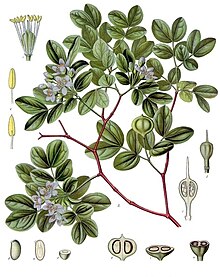Guaiacum officinale
| Guaiacum officinale | ||||||||||||
|---|---|---|---|---|---|---|---|---|---|---|---|---|

Guaiacum officinale |
||||||||||||
| Systematics | ||||||||||||
|
||||||||||||
| Scientific name | ||||||||||||
| Guaiacum officinale | ||||||||||||
| L. |
Guaiacum officinale is a tree in the yoke family from the Caribbean , Venezuela , Colombia and the Guyanas as far as Central America .
description
Guaiacum officinale is a small, evergreen , slow-growing tree with a dense crown that grows to around 10-12 meters high. The trunk diameter reaches 50-60 (100) centimeters. The grayish to brownish bark is peeling off in patches. The tree has a reddish-brown resin ( guajak resin , Resina Guajaci), it is obtained directly from the trunk or by melting it out of the wood .
The opposite, stalked, small leaves are pinnate in pairs with mostly 4–6 (8) almost sessile, glabrous and leathery leaves . The rachis and the petiole are slightly hairy. The foremost, the 2–4.5 cm large leaflets are the largest. The obovate, entire leaflets are rounded to rounded. The stipules are mostly sloping.
The relatively large flowers appear singly or in groups, terminal or axillary. The light purple to white, stalked flowers are usually four to five-fold with a double flower envelope . The egg-shaped, small sepals are somewhat fine-haired. The sweeping petals are nailed with a rounded, pointed plate . There are 8–10 free stamens . The short-stemmed, multi-chambered and laterally compressed ovary is upper constant with short, conical stylus and minimal, capitate stigma . There is a discus .
There are small, leathery, pointed, short-winged and flattened, two-part, yellow to orange-yellow when ripe, as well as wide-inverted or heart-shaped, smooth, glabrous, septicidal, about 1.6-2 centimeters large capsule fruits with usually one or two Seeds formed. The flat seeds are wrapped in a fleshy, red aril . The flat, yellowish-beige and egg to crescent-shaped seeds are 1–1.2 centimeters long without aril.
The number of chromosomes is 2n = 26.
Taxonomy
The first description was in 1753 by Carl von Linné. Synonyms are Guaiacum bijugum Stokes and Guaiacum breynii Spreng.
use
The very hard, very heavy, stable, waxy wood, "Lignum vitae", lignum vitae , French wood, iron wood is highly sought after. Wood from Xanthocercis madagascariensis or from Bulnesia arborea is used as a substitute .
The resin is used as a food additive or for chewing gum, but also medicinally.
literature
- Duncan M. Porter: The Genera of Zygophyllaceae in the Southeastern United States. In: Journal of the Arnold Arboretum. Vol. 53, no. 4, 1972, pp. 531-552, JSTOR 43781817 .
- J. A: Vozzo: Tropical Tree Seed Manual. USDA Forest Service, 2002, p. 483 ff, limited preview in the Google book search.
- Martin Chudnoff: Tropical Timbers of the World. Agriculture Handbook 607, USDA Forest Service, 1984, pp. 33, 85, limited preview in Google book search.
Web links
- Guaiacum officinale at NYBG.
- Guaiacum officinale at Useful Tropical Plants.
- Guaiacum officinale at the useful plant database Uni Marburg.
- Guaiacum officinale at Henriette's Herbal Homepage.
- Guaiacum officinale on plantsystematics.org (pictures).
Individual evidence
- ↑ R. Hansel u. a .: Hager's Handbook of Pharmaceutical Practice. 5th Edition, Drugs: E-O , Springer, 1993, ISBN 978-3-642-63427-7 (Reprint), pp. 353-357.
- ↑ R. Hansel, O. Sticher: Pharmakognosie - Phytopharmazie. 8th edition, Springer, 2007, ISBN 978-3-540-26508-5 , pp. 1184, 1186 f.

